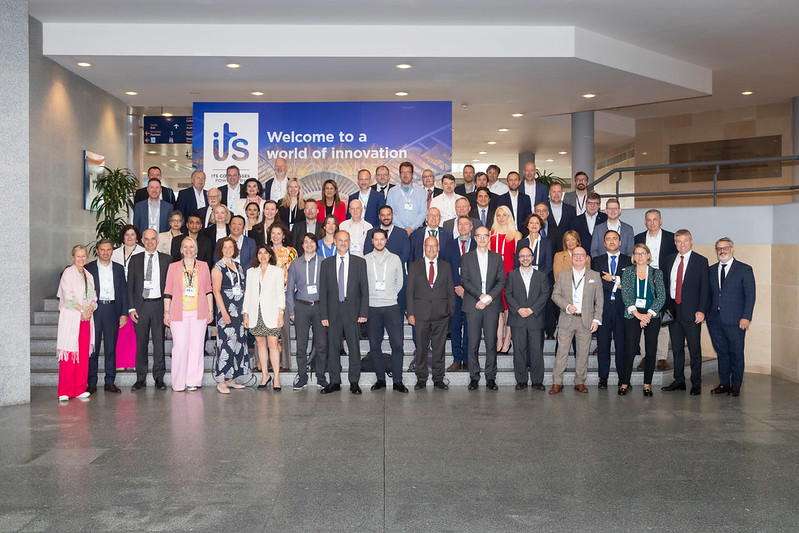Lisbon, 22 May 2023. Senior representatives from over 30 cities and regions from across Europe, the Middle East and Africa met to discuss how intelligent and green mobility can contribute to sustainable growth and a better quality of life for all citizens. The Smart Mobility Summit of Cities and Regions is one of the key highlights of the 15th ITS European Congress, ‘ITS: The Game Changer’, offering a unique opportunity to meet with peers, alongside a select group of industry technology representatives, to discuss challenges, possible solutions and future opportunities. Cities and regions of the Summit benefitted from a very candid briefing by the European Commission on the significance of the Sustainable Urban Mobility Plans (SUMPs) and the related Sustainable Urban Mobility Indicators (SUMIs). Emerging issues were identified in which closer collaboration and wider knowledge sharing could benefit all parties. Overall, the Smart Mobility Summit highlighted that the transition towards sustainable mobility requires a multifaceted approach, including education, infrastructure development, and policy changes. By learning from each other and sharing best practices, cities can work towards achieving a more sustainable and liveable future for all.
In his keynote, Mr Torsten Klimke, Head of Unit Innovation & Research, DG MOVE, emphasised the importance of supporting cities across Europe and beyond as they play a key role in developing future mobility. The Commission seeks to learn from all the cities and regions in order to understand what is needed to facilitate the uptake of frameworks in addition to the Trans-European Networks for Transport (TEN-T), the SUMP and the new Urban Mobility Expert Group. The Commission is working on regulatory actions to accelerate the availability of sustainable mobility services given the need to connect urban and rural mobility ecosystems, focusing on flexibility, user-friendly and demand-based solutions. Within the EU Urban Mobility Framework, 424 cities with over 100,000 inhabitants will develop Sustainable Urban Mobility Plans (SUMP). The Sustainable Urban Mobility Indicators[1] are now being finalised to monitor the progress of their implementation by collecting data for seven sustainable mobility-related areas such as climate effects, safety, inclusiveness and affordability.
ERTICO – ITS Europe’s Chairman, Dr Angelos Amditis, and CEO, Mr Joost Vantomme, noted ERTICO’s commitment to continue facilitating and promoting an impactful network to support local and regional authorities’ agendas of driving innovation and implementing smart and sustainable mobility solutions for public benefit. Summits like these provide productive ways to gather the views of all stakeholders and decision-makers to guide the development of strategies for providing smarter and integrated mobility. The following round table discussions considered four aspects:
1 City Road Space Allocation
The challenges of allocating city road space centred on assessing the overall capacity for a road and deciding priorities for each class of use while anticipating future developments. The dialogue provided an opportunity to exchange ideas and solutions to meet the challenges of allocating city road space and to learn from their counterparts. One of the major difficulties discussed was getting political decisions on allocating the physical space. This is not just between private and public passenger vehicles and freight but also active modes including cycling and walking. Processes for analysing and quantifying the costs and benefits of different solutions are urgently needed. The participants noted that most cities aim to strengthen parking space management in anticipation of the deployment of automated vehicles. However, there is a growing demand for more guidance on best practices and how to (re)design and install technologies to enable dynamic reallocation of road space. A final important note that emerged from the discussion highlighted the need to communicate with citizens from a strategic perspective. This includes co-benefits for citizens and the need to reduce air pollution whilst facilitating more active mobility modes to cater to different user needs.
2 Setting and using mobility indicators
Summit participants at the second table discussion noted the importance of monitoring and evaluating the performance of local delivery systems by setting and using Sustainable Urban Mobility Indicators (SUMIs). Many cities are already using some metric, with several using the set of practical and reliable indicators developed by the European Commission to provide a standardised evaluation of mobility. There are many benefits from maintaining a set of indicators: They give politicians and regulators continual feedback on the impact of policies; and they give infrastructure managers a direct view of their systems’ performance. Both factors help to inform overall city planning and encourage cooperation between different administrative sectors. However, it was also highlighted that there are challenges in adapting and developing indicators to address qualitative factors such as accessibility, equity, inclusivity and quality of life. Participants recognized the need for a mechanism to share know-how.
3 Collecting and using mobility data
Another table discussion focused on the need to increase public awareness and trust regarding the collection and use of mobility data. The past few years have shown how digitalising transport improves service delivery and enables the creation of new services. However, it is important for cities to understand how they intend to use the collected data, not just for immediate purposes but also for possible future applications. This requires using published standards and identifying privacy and security concerns as soon as possible. The delegates highlighted the need for a storehouse of guidance learned from cities’ experience collecting and using mobility data. Key topics were improving data quality; deploying open data practices to encourage innovation; making wider use of National Access Points (NAPs), and mobility data spaces; and forming private-public partnerships combining data from public sources with the private sector. The concluding remarks of this discussion presented questions on how we drive knowledge sharing, including standards, but also experimenting together.
4 Transitioning to sustainable mobility
Transitioning to sustainable mobility is an important step for cities to achieve their environmental goals and ensure their citizens’ better quality of life. Developing a Sustainable Mobility Plan is an excellent way for cities of all sizes to focus on key issues locally. The policies required to achieve this goal are likely to be a mix of high-level objectives set by the national government and smaller local initiatives, but a common thread is a need for all classes of stakeholders to work together on both planning and delivery issues. Cities also need to recognise that many policies will rely on improving or extending infrastructure for public transport and active mobility modes including cycling, and walking. Citizens need to understand the arguments for seeking behavioural change, and education campaigns should be put in place to inform them of the benefits of sustainable mobility and get their support. One fundamental point is the need for pre and post-evaluation of transition strategies, which should be cross-linked to mobility indicators.
Although the four topics were discussed separately, it was clear that they overlapped. For example, a key element in sustainable mobility is changing the patterns of road traffic and the use of city space which in turn rests on understanding the best tools for last-mile logistics. These include micro-distribution hubs, urban vehicle access regulations, dynamic road space allocation, and achieving change through incentives or penalties. Each tool has its own advantages and disadvantages, and finding the right combination of tools is crucial for successful implementation. A major question in nearly all discussions is the role of automated transport in sustainable mobility. While there are potential positive impacts, such as increased efficiency and reduced emissions, there are also potential negative societal impacts, such as job loss and increased traffic congestion. It was therefore important to consider the potential impacts of automated transport carefully and incorporate them in planning.
The Summit delegates were pleased to have the opportunity for a full and frank exchange of views on sensitive and complex issues. The participants noted that addressing the issues discussed under each topic requires a multi-stakeholder approach, constantly focusing on user consultation. They also noted the need for more research to analyse and quantify the costs and benefits of different configurations of city space and the need for mobility indicators that assess qualitative factors such as accessibility and equity. More work was needed on understanding behavioural issues ─ particularly important when seeking to achieve a modal shift ─ and the impact on mobility demand and supply of an ageing population. Finally, there was a common need for an open-access storehouse of guidance derived from cities’ experience of collecting and using mobility data. The participants are keen to continue working together on addressing city mobility challenges through the deployment of efficient and sustainable ITS solutions.
In his concluding remarks, Professor Eric Sampson CBE, Master of Ceremonies and Chief Rapporteur, commented on how cities frequently experienced the same types of policy problems but mechanisms for discussing and sharing solutions at the city level ─ such as the Summit ─were scarce. Common problems discussed included:
Deciding the target balance between better accessibility to a city, both passenger and freight, for economic reasons; and devoting space to trees/green infrastructure, traffic calming, and controlled emission zones for better liveability;
Developing greater cooperation between the private and public sectors regarding collecting and using data in mobility services;
Ensuring that energy demand and supply issues were always integrated into ITS planning;
Getting the public and private sectors to recognise that the other side has different objectives and obligations regarding the availability of data and sharing it ─ and that the two requirements can co-exist;
Improving trust between all stakeholders; it is the cornerstone of the mobility eco-system and essential for data sharing;
Putting in place a long-term skills and training plan for the mobility sector;
Understanding the impact of Artificial Intelligence on mobility services.
[1] The indicators include greenhouse gas emissions, congestion, deaths and serious injuries caused by road crashes, modal share for all modes, access to mobility services, and air and noise pollution.
The post Smart Mobility Summit of Cities and Regions: Top decision-makers meet to improve city mobility appeared first on itseuropeancongress.com.

